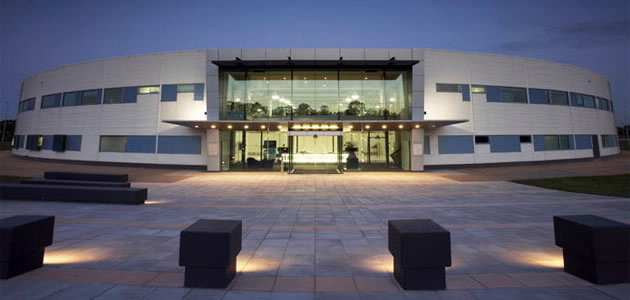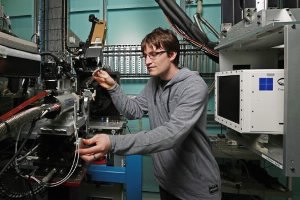 |
| Australian Synchrotron, located at Clayton, Melbourne |
Australian scientists today celebrated the publishing of the 1000th science paper as a result of research partnerships with the Australian Synchrotron, located in Clayton, Melbourne.
The milestone was achieved after Monash University researchers entered the 1000th paper into the publications database.
The Australian Synchrotron was established just six years ago, and is one of the largest stand-alone pieces of scientific infrastructure in the southern hemisphere.
The Synchrotron is a “lightsource” – it generates extremely bright light, ranging from infrared to hard x-rays, and serves thousands of Australian, New Zealand and other international academic and industrial researchers.
The work in the 1000th paper, by William Gee and Stuart Batten, consider the development of new molecular tools needed to explore and develop materials with advantageous properties.
See the publication
In this case the researchers were exploring a new class of materials suitable for application in molecular sensing, CO2 capture, and hydrogen fuelled transportation.
Interim Director, Professor Andrew Peele, celebrated the achievement, and the work of the dedicated scientists involved.
“The fact that we have contributed to 1000 pieces of research in just six years is a real testament to both the dedication of our staff and strength of our partnerships,” said Professor Peele.
 |
| Dr William Gee, a synthetic chemist from Monash University |
“It is a singular achievement to have passed this milestone in a facility with just nine beamlines (experimental stations). Further, we are on track to reach 2000 papers in just three more years.”
Professor Peele said the Australian Synchrotron has established itself as one of Australia’s premier research facilities, and said work is ongoing to secure its future.
“With stable operations provided through the Australian Nuclear Science and Technology Organisation (ANSTO) but with funding secure for only three more years, we still have work to do to ensure the Synchrotron becomes truly national,” said Dr Peele.
“ANSTO and the Synchrotron are working together to achieve a long term funding solution, and new investment will develop and expand the Synchrotron’s capabilities to reach their full potential.
“With more beamlines, the Australian Synchrotron could produce 1000 papers in a single year.
“The benefit to society in health, pharmaceuticals, mining, electronics, energy, environment, agriculture and other high technology endeavours would be enormous.”
ANSTO took on operational management of the Australian Synchrotron from 1 January this year.
| Professor Stuart Batten from Monash University |
ANSTO’s CEO, Dr Adi Paterson, welcomed the 1000th paper and said that ANSTO looks forward to seeing more great results from the Melbourne facility.
“In the short term, the new arrangements enabled the Synchrotron to continue operations and their important contribution to Australian scientific research,” said Dr Paterson.
“The immense scientific output from this organisation, as evidenced by the significant milestone of 1000 research papers in just six years, cannot be doubted.
“Having ANSTO and the Synchrotron work together is enabling us to build on links between the user services, and ongoing development of our facilities, particularly x-ray and neutron scattering, and accelerator science.”
The 1000th paper is: William J. Gee and Stuart R. Batten. Cuprous Halide Complexes of a Variable Length Ligand: Helices, Cluster Chains, and Nets Containing Large Solvated Channels. Crystal Growth & Design, 13 (6), 2335–2343 (2013).
Published: 25/07/2013


